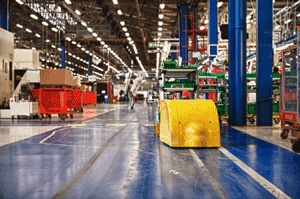10 Ways to Improve Warehouse Efficiency and Reduce CostsCurt Barry February 2, 2017

A client quipped the other day, “You know, managing a multichannel warehouse is a pretty easy thing. All you have to do is manage the labor, the freight and the inventory!”
And from there a thousand other factors assault you. In some ways he’s right though. Shipping has become the number-one cost in fulfillment and requires constant review and change to keep costs in line or minimize increases. The cost of labor is increasing in many markets as the economy improves ever so slowly. Faced with increases in the minimum wage, many of our ideas focus on how to gain more productivity per labor hour. In our Seattle minimum wage article we asked readers how they improved productivity through incentive pay and were able to pay the employee more. While comments came to us for weeks, not one was offered for incentives and paying employees more. Inventory is the number-one balance sheet asset in most multichannel businesses. Slotting and location control help you track product within the warehouse’s four walls and fulfillment processes. So it is easy! Here are 10 ways to improve your warehouse efficiency and reduce costs.
1. Controlling inbound and outbound freight控制好进库和出库发运环节
Virtual libraries are being filled with articles on how to reduce or slow down this area of cost. It must be your number-one ongoing focus to prevent profit erosion. Use a consultant to help you competitively bid. While carrier agreements are proprietary, experienced consultants can still help identify areas to negotiate reductions without hurting service levels.
2. Incentive pay设计好的薪酬激励
Properly engineered incentive pay for performance can bring the biggest percent improvement in labor productivity. More than 50% of your warehouse labor is in pick and pack, so start there. You always need to be sure you’re not paying for productivity you’re already getting or could get in other ways.
3. Simplify Processes – Reduce Touches – Reduce Costs简化流程-减少搬运-降低成本
Over the years, have you been layering new functions over longer term existing ones? Do product flow and order flow no longer make sense and crisscross the floor? Take a fresh look at the physical processes and steps involved in product flow and order fulfillment. Generally speaking, less steps equal fewer touches equal lower costs.
4. You Can’t Improve Something You Haven’t Measured …. Feedback to the Employee没有衡量基准就无法改善, 定期向员工公布衡量和改善结果
Does your operation capture and manage critical KPIs? Do you know your critical productivity and costs on shipped orders, cost per box and cost per line shipped? I was in a $20 million company the other day and they couldn’t show me these critical metrics. How can we assess and put in place cost reduction measures if we don’t know the baseline? What do various types of errors cost? What do returns cost? Once these things are established, THEN create regular feedback to the employees on individual and departmental performance. They’ll respond and give you higher productivity.
5. Develop More Effective Frontline Managers培养更优秀的现场管理者
Effective managers know it’s all about execution. Their ability to efficiently manage all aspects of fulfillment radically affects your costs, worker morale and the quality of customer order fulfillment. What are their individual needs? What exposure to other aspects of your business will help them understand your merchandise, your customers and vendors? What training resources are available online or locally?
6. Inbound Supply Chain 做好收货入库环节的系统性工作
Changes to supply chain include scheduling inbound purchase orders to manage the receiving dock and yard better. Develop vendor compliance policies, including purchasing terms and conditions, on-time delivery, quality and item specifications, routing guides and importing guides, product packaging and labeling and drop ship vendor standards. Push quality and value-added services up the supply chain to the vendors so the product is ready to be put away or shipped. This reduces labor for rework of mistakes.
7. Voice-Enabling Technology应用语音技术
Some vendors reduced the costs to make this technology available to all different sized businesses. Voice enabling can be applied to all processes and departments – from receiving to shipping and returns – for better inventory control and increased productivity. These systems have quick install times, require no IT or modifications to your WMS, don’t require extensive training and have a fast ROI – as quickly as four to six months. Do your due diligence though, because not all voice applications are created equal.
8. Consider Third-Party Fulfillment合理评价第三方的执行能力
Third party fulfillment (3PF) isn’t for everyone. Many of our clients believe they can do fulfillment cheaper and with higher quality themselves. However, we have seen good experiences from 3PF at costs competitive with internal costs. Using a 3PF partner means capital isn’t tied up in new facilities and systems. For smaller companies 3PF lets management concentrate on marketing and merchandising functions essential to sustain growth. When you need to increase warehousing, storage or order throughput, look at 3PF as an option.
9. SaaS Versus Licensed On Premise Systems SaaS和授权服务的比较
The investment in new order management, enterprise wide or WMS systems is something that companies do only every 5-10 years because of the investment and implementation time frame. A SaaS subscription model provides an option for acquiring a new system at a lower cost. However it’s important to understand the SaaS costs long term vs. the one-time purchase and annual support of traditional systems. Also compare the detail of warehousing function in SaaS WMS. You generally find more effective warehouse functions which can decrease costs and improve service.
10. Continuous improvement process. 持续改善
Great merchants and marketers measure everything and do post mortems of their promotions and results. Do an assessment. Work out a plan. Set objectives and accountability for improvement, review progress and start again.
这家伙很懒,还没有设置简介